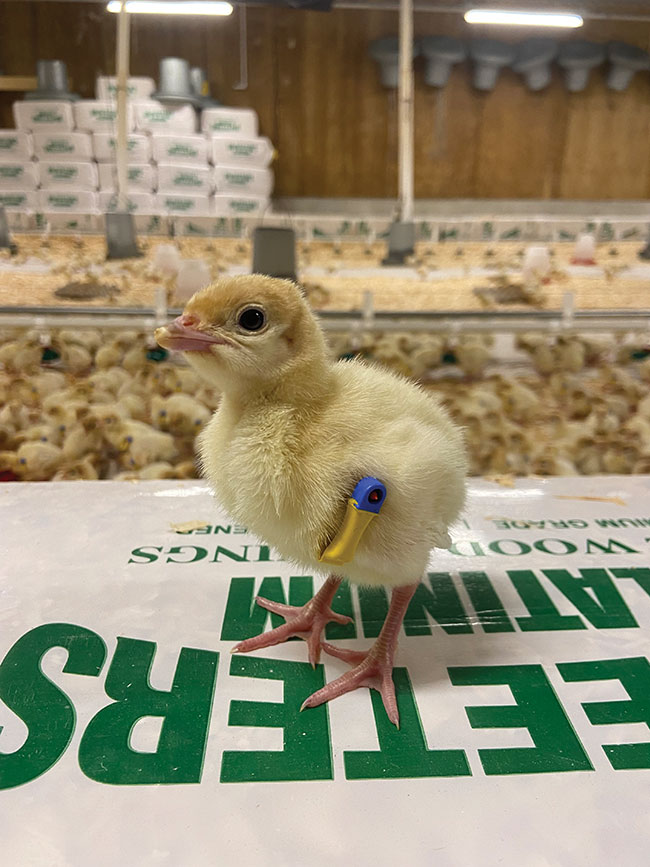
RFID in Turkey Breeding: A better path to progress
By Jane Robinson
Features New Technology Hybrid Turkeys RFID SustainabilityRFID technology improves sustainability in turkey breeding
 All turkeys in Hybrid Turkeys’ breeding program are fitted with an RFID wing tag at the hatchery that tracks information throughout their lifespan. PHOTO CREDIT: Hybrid Turkeys
All turkeys in Hybrid Turkeys’ breeding program are fitted with an RFID wing tag at the hatchery that tracks information throughout their lifespan. PHOTO CREDIT: Hybrid Turkeys For about two decades, Canadian livestock farmers have used radio frequency identification (RFID) to track and trace animals. Hybrid Turkeys has adapted and integrated the technology into its breeding program, improving the rate, accuracy and sustainability of genetic progress.
“RFID helps us gather more information on our birds so we can make better decisions on which birds to keep in the breeding program to create the next generation,” says Jeff Mohr, protocol manager with Hendrix Genetics, the parent company of Hybrid Turkeys. “The work we are able to do through RFID to gather individual bird information is improving the overall level of genetic progress for turkey producers.”
Hybrid Turkeys offers breeding and commercial stock in Canada and around the world. It implemented the RFID technology at the pedigree level in Canada in March 2021, so all customers are now benefitting from the genetic progress the company has made in its breeding program using the technology.
“Over the years, the cost of RFID technology has decreased and made it a more feasible option for other species, including turkeys,” says Mohr, who is part of the R&D team that works on the RFID technology. “We were using bar codes to track feed efficiency and feed consumption, but now we can accomplish this more efficiently and sustainably with RFID.”
RFID represents a refinement on bar code technology, a simpler, less automated system used to track animal movement and gather production information. For Hybrid Turkeys, RFID technology delivers real time, accurate data on traits such as bird growth to enhance genetic progress, and signals a move to a more sustainable practices for birds and workers.
All turkeys in their breeding program are fitted with an RFID wing tag at the hatchery that tracks information throughout their lifespan to processing. Every time a bird steps on a scale or enters a feeding station, they are pinged, and information is gathered on their feed consumption and live weight.
Accurately measuring feed conversion on an individual bird basis is the area most established with RFID technology for Hybrid Turkeys. “We can make better progress on feed efficiency with RFID because we have a larger population of data that gives us better validation to confirm what is possible with the birds down the road,” says Blair McCorriston, marketing manager with Hendrix Genetics.
“This greater level of accuracy helps ensure genetic progress and enhances the speed at which we can deliver improvements. This progress results in things like increased body weight with strong legs and livability and improved feed conversion for our breeder and commercial customers.”
Three-way sustainability
The other win with the RFID technology for Hybrid Turkeys is that genetic progress comes in a more sustainable system, something the company evaluates in three distinct ways – social, economic and environmental sustainability.
Social sustainability refers to enhancing animal welfare by reducing the handling of birds required through the selection process. “RFID allows us to capture data in a passive way so birds can express their natural tendencies while we collect the required information,” Mohr says. The technology reduces the need to physically handle and weigh birds, improving worker experience and reducing stress for the birds.
Economic sustainability comes from the ability to breed birds that perform more efficiently to deliver continuous economic returns that customers depend on.
And from an environmental footprint perspective, Hybrid Turkeys is using RFID on limited resource and high-cost inputs like feed to improve on-farm efficiencies. “We have done studies that show improvements in feed efficiency have a direct correlation to reducing greenhouse gas emissions, so this technology is speeding up genetic progress while lessening our impact on the globe,” McCorriston says.
What’s next with RFID
The opportunities that RFID technology has opened up for Hybrid are endless. By tracking feed consumption, they are also inherently gathering behavioural information on their breeding birds.
“When we look at feeding data over time, we start to see behaviour-based patterns,” Mohr says. “Are the birds eating two big meals a day or six smaller ones? Do they eat more in the morning or afternoon? And what changes in their eating patterns in cool versus warm weather?”
A video component is included in all Hybrid’s RFID studies – mostly for validation of tracked data – but in the future they may look at combining video with RFID technology to measure behavioural activity including interaction with other birds.
“We are looking at expanding the type of passive data we can collect on individual birds in our breeding program including body weights, leg strength, interaction with pen mates, movement throughout the pen and eating patterns,” Mohr says.
One of the company’s newest trials applying RFID is an automatic nest system. “We started a trial earlier this year on a small flock of breeder females to track individual egg production,” he says.
Print this page